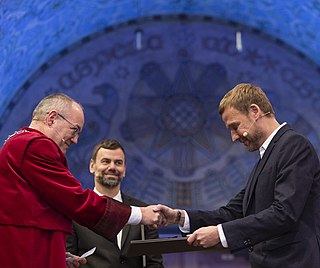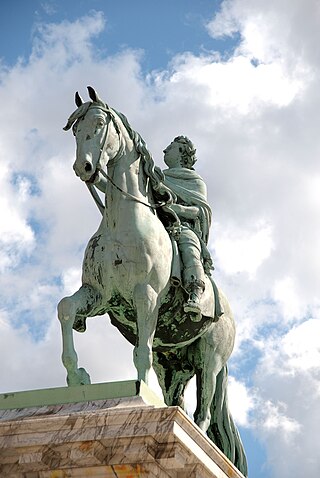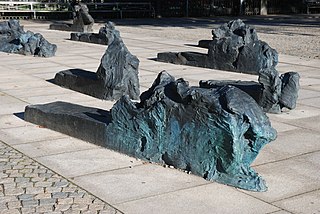Related Research Articles

Ann Lislegaard is a contemporary artist living and working in Copenhagen, Denmark and New York City, US. She is known for her 3D film animations and sound-light installations often departing from ideas found in science fiction. She finds in Science fiction an alternative approach to language, narration, gender roles and concepts of the future.

Michael Elmgreen and Ingar Dragset have worked together as an artist duo since 1995. Their work explores the relationship between art, architecture and design.

Peter Brandes is a Danish painter, sculptor, ceramic artist and photographer.
Per Bak Jensen is a Danish landscape photographer. His desolate images of nature or industrial sites often convey an almost metaphysical impression. His unusual subjects include corn stubble, twigs in the snow or a few isolated rocks. Always attentive to angle, light and exposure, he never manipulates his photographs once they have been taken.
Trine Søndergaard, is a Danish photography-based visual artist. Trine Søndergaard lives and works in Copenhagen, Denmark.
Nicolai Howalt is a Danish visual artist and contemporary photographer.

Danish sculpture as a nationally recognized art form can be traced back to 1752 when Jacques Saly was commissioned to execute a statue of King Frederick V of Denmark on horseback. While Bertel Thorvaldsen was undoubtedly the country's most prominent contributor, many other players have produced fine work, especially in the areas of Neoclassicism, Realism, and in Historicism, the latter resulting from growing consciousness of a national identity. More recently, Danish sculpture has been inspired by European trends, especially those from Paris, including Surrealism and Modernism.

Rasmus Morten Andersen was a Danish sculptor. He is mainly known for his naturalistic portraits.
Knud Nellemose was a Danish sculptor who is remembered for his figures of sportsmen and his statues of famous Danes.

Jørgen Haugen Sørensen was one of Denmark's most eminent sculptors. He had his artistic debut at the acclaimed and prestigious Spring Exhibition (Forårsudstillingen) at Kunsthal Charlottenborg, Copenhagen in 1953. Haugen Sørensen was a member of the artistic union Decembristerne and the artist collective Grønningen, as well as Veksølund in Denmark.

Morten Stræde is a Danish sculptor. He attended the Royal Danish Academy of Fine Arts from 1978 to 1985 and later became a professor there (1994–2002). Morten Stræde had his breakthrough in the 1980s; in his art he uses both organic as well as geometric styles. In 2011, he created three new urban spaces in the Nørrebro borough in Copenhagen.

Kirsten Møller Ortwed is a Danish artist, now based in Cologne, Germany. She is noted for her striking sculptures in public spaces and her sometimes surprising combinations of traditional and unconventional materials.
Michael Otto Albert Kvium is a Danish artist. He has excelled in a number of fields such as painting, illustrating, sculpting and various performance genres. Since the early 1980s, he has created grotesque realistic works, depicting the darker side of life.
Lene Adler Petersen is a Danish artist. Her artistic practice is characterized through a continuous collecting, sorting and mixing process of media and techniques and includes happenings and performance art as well as painting, ceramics, drawings, printmaking and installations, film and photography.
Sophia Kalkau is a Danish artist, who works in a variety of media including writing, photography, sculpture and installation. Sophia Kalkau has studied Art History at Copenhagen University and holds a degree in Art Theory from the Royal Danish Academy of Fine Arts. She is the author of numerous publications on aesthetics.
Dorte Dahlin is a Danish artist who entered the art scene in the early 1980s as part of the Wild Youth trend. She gained recognition from her participation in the 1982 exhibition Kniven på hovedet held at Tranegården in Gentofte. More recently, she has created decorative objects for churches.
Jens Faurschou is a Copenhagen-based art collector and art advisor. He is the founder of several art-related institutions, most notably the contemporary art institution, Faurschou Foundation. He is also founder of Copenhagen's centre for large-scale contemporary installation art, Copenhagen Contemporary, and co-founder of the Danish production company for virtual reality art, Khora Contemporary.

Carl Krull is a contemporary Danish artist. Best known for his "seismic" approach to sculptural drawing and painting, Krull works in various media, including sculptural drawing, sculpture, printmaking, virtual reality, and digital media.
Erik August Frandsen is a Danish contemporary artist. In the early 1980s Erik A. Frandsen was part of the artistic movement de unge vilde and in 1981, he co-founded the artist collective Værkstedet Værst with prominent working with artists such as Lars Nørgård and Christian Lemmerz. He currently works from studios in Copenhagen, Nordfalster and Como, Italy.

Sofie Hesselholdt and Vibeke Mejlvang are a collaborative duo of visual artists who live and work in Copenhagen. They started collaborating in late 1999 and work with performance art and site-specific installations in public spaces addressing social and political topics such as National Identity and Eurocentrism.
References
- 1 2 "Christian Lemmerz" (in Danish). danskefilm.dk. Retrieved 2 November 2014.
- 1 2 "Christian Lemmerz | Gyldendal - Den Store Danske". denstoredanske.dk (in Danish). Retrieved 2020-03-23.
- ↑ Overgaard Hansen, Kamma. "Værkstedet Værst". Den Store Danske (in Danish). Retrieved 2023-03-12.
- ↑ Overgaard Hansen, Kamma. "Performancegruppen Værst". Den Store Danske (in Danish). Retrieved 2023-03-12.
- ↑ "Værkstedet Værst" (in Danish). KunstOnline. Retrieved 2 November 2014.
- 1 2 Ann Lumbye Sørensen. "Christian Lemmerz" (in Danish). Kunstindeks Danmakr & Weilbachs Kunstnerleksikon. Retrieved 2 November 2014.
- ↑ "Christian Lemmerz" (in Danish). Retrieved 2020-03-23.
- ↑ "Christian Lemmerz, Germany/Denmark". Hans Alf Gallery. Archived from the original on 2 November 2014. Retrieved 2 November 2014.
- ↑ Christian Lemmerz : genfærd. Lemmerz, Christian, 1959-, Aarhus kunstmuseum. Åarhus: ARoS Åarhus Kunstmuseum. 2010. ISBN 978-87-92184-08-5. OCLC 727107290.
{{cite book}}: CS1 maint: others (link) - 1 2 "Marble | Christian Lemmerz" (in Danish). Retrieved 2020-03-23.
- ↑ "Tildelinger af medaljer". Akademiraadet. Archived from the original on 2 February 2015. Retrieved 25 January 2014.
- ↑ "Christian Lemmerz" (in Danish). Den Store Danske. Retrieved 2 November 2014.
- ↑ "Christian Lemmerz". www.kunst.dk. Retrieved 2020-03-23.